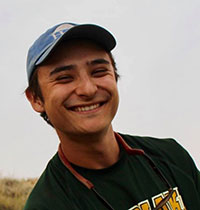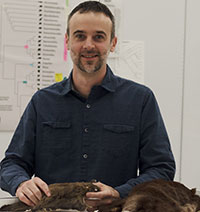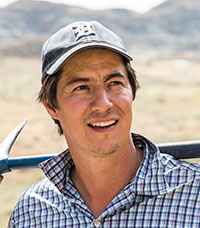 Alexandria L. Brannick. Department of Biology, University of Washington, Seattle, Washington, 98195-1800, USA. alexbrannick@gmail.com
Alexandria L. Brannick. Department of Biology, University of Washington, Seattle, Washington, 98195-1800, USA. alexbrannick@gmail.com
Alexandria Brannick studied Geology and Environmental Geosciences at Lafayette College (B.Sc.) and Biological Sciences at Marshall University (M.Sc.). She then joined the University of Washington where her dissertation research focused on the evolution and feeding ecologies of North American metatherian mammals. She received her Ph.D. from the University of Washington in 2021. She has since moved away from research and academia and transitioned into an industry profession.
![]()
 Henry Z. Fulghum. Committee on Evolutionary Biology, University of Chicago, Chicago, Illinois, 60637, USA. hzf@uchicago.edu
Henry Z. Fulghum. Committee on Evolutionary Biology, University of Chicago, Chicago, Illinois, 60637, USA. hzf@uchicago.edu
Henry Fulghum studied at both the University of Washington (B.Sc.) and Indiana University Bloomington (M.Sc.). He is a vertebrate paleontologist and evolutionary biologist studying the influence of functional morphology on macroevolution. He is specifically interested in Mesozoic mammals, and his research focuses on using functional morphologies and ecological traits in order to study the tempo and mode of their evolution.
![]()
 David M. Grossnickle. Oregon Institute of Technology, Natural Sciences Department, Klamath Falls, Oregon, 97601, USA. david.grossnickle@oit.edu
David M. Grossnickle. Oregon Institute of Technology, Natural Sciences Department, Klamath Falls, Oregon, 97601, USA. david.grossnickle@oit.edu
David Grossnickle is an evolutionary biologist interested in how functional traits influence macroevolution. His preferred study organisms are mammals, both modern and extinct. Much of his research has focused on early mammals from the Mesozoic Era (or Age of Dinosaurs), but he has also studied modern mammals to address questions about evolutionary processes, convergence, and functional morphology. He received his Ph.D through the Committee on Evolutionary Biology at the University of Chicago in 2018.
![]()
 Gregory P. Wilson. Mantilla Department of Biology, University of Washington, Seattle, Washington, 98195-1800, USA and Burke Museum of Natural History and Culture, Seattle, Washington, 98195-1800, USA. Corresponding author. gpwilson@uw.edu
Gregory P. Wilson. Mantilla Department of Biology, University of Washington, Seattle, Washington, 98195-1800, USA and Burke Museum of Natural History and Culture, Seattle, Washington, 98195-1800, USA. Corresponding author. gpwilson@uw.edu
Dr. Gregory Wilson Mantilla is a Professor in the Department of Biology and a Curator of Vertebrate Paleontology at the Burke Museum at the University of Washington. He is also a Research Associate at the University of California Museum of Paleontology and was a Curator of Vertebrate Paleontology at the Denver Museum of Nature & Science. Greg attended Stanford University as an undergraduate and received his PhD in Integrative Biology from the University of California, Berkeley in 2004 and was an NSF Postdoctoral Fellow at the University of Helsinki in 2005. He has undertaken field work in various places around the world, including India, Niger, Ethiopia, Colombia, Bolivia, and Montana. His research aims to understand critical transitions in the deep-time history of life. One of the most captivating of these transitions is the early radiation of mammals, which ultimately led to their striking diversity today, from the tiny, flying bumblebee bat to the titanic, fully aquatic blue whale. Work from his lab has elucidated paleoecological and macroevolutionary patterns of early mammals in the context of dinosaur-dominated terrestrial ecosystems, the breakup of Pangaea, and the mass extinction at the end of the Mesozoic (K/Pg).

